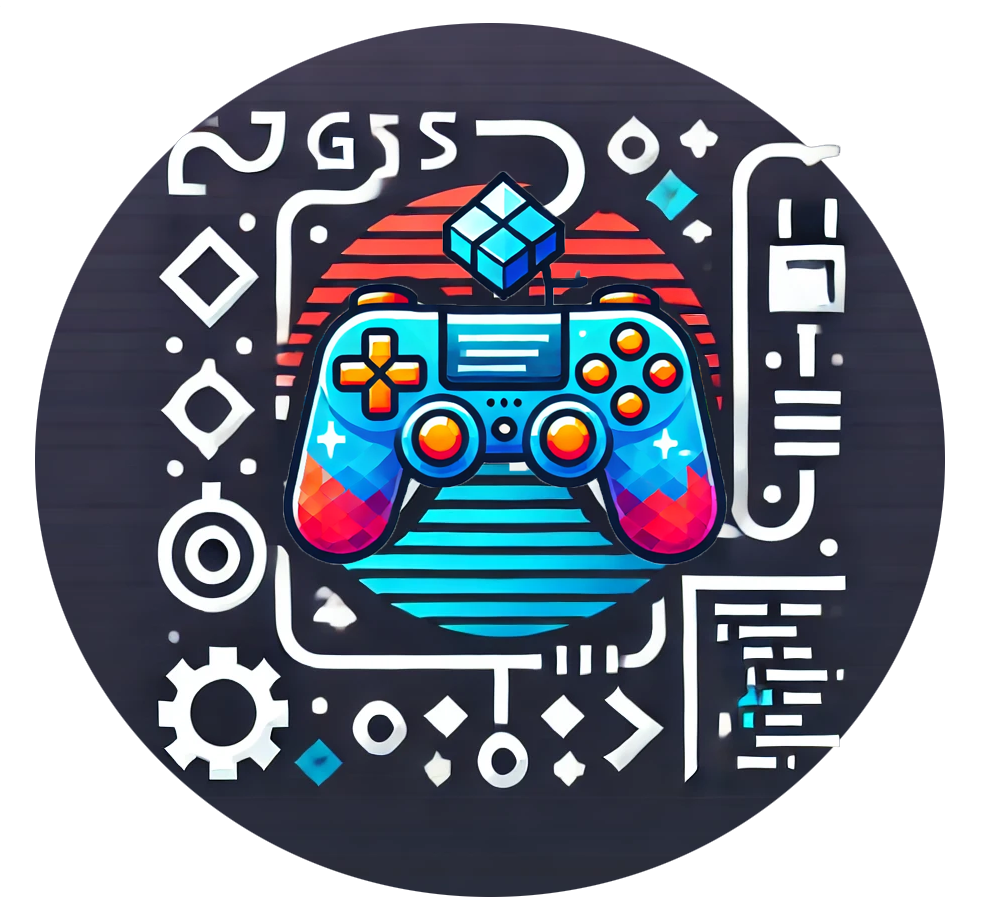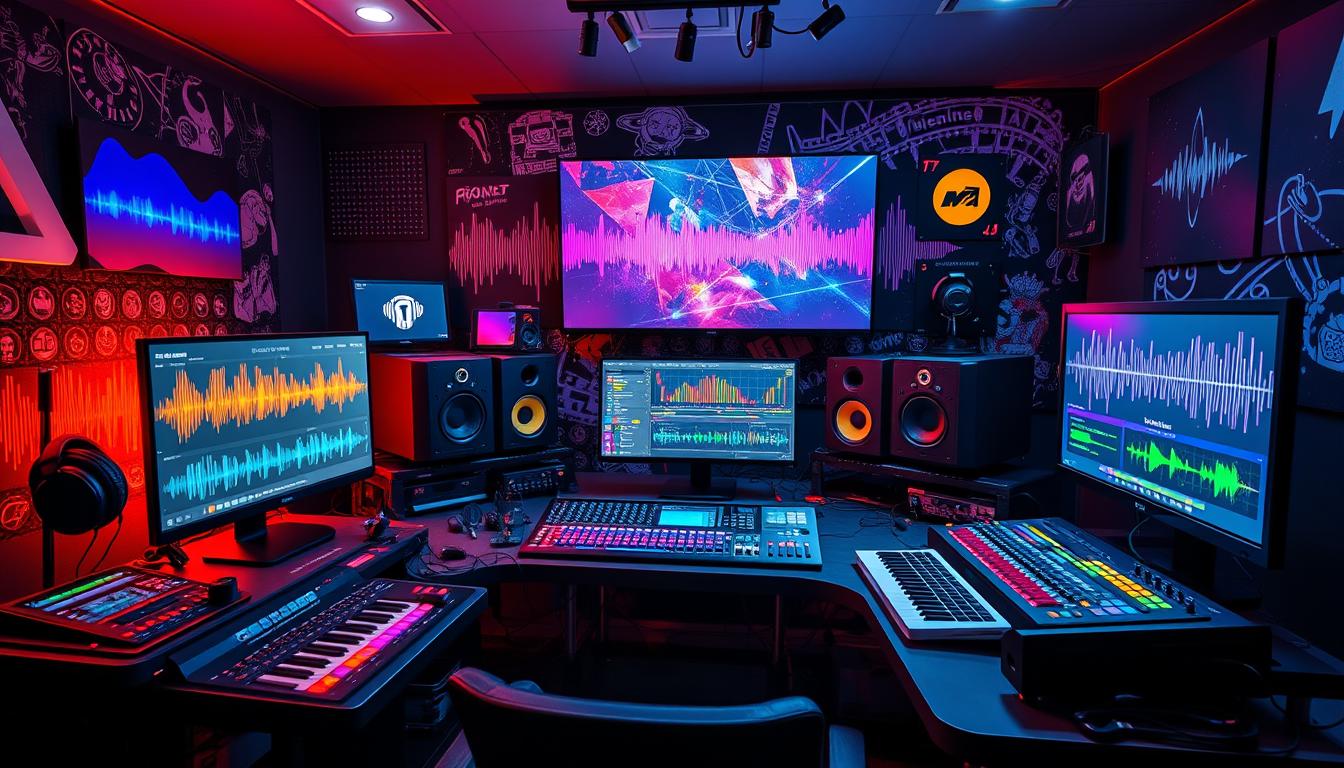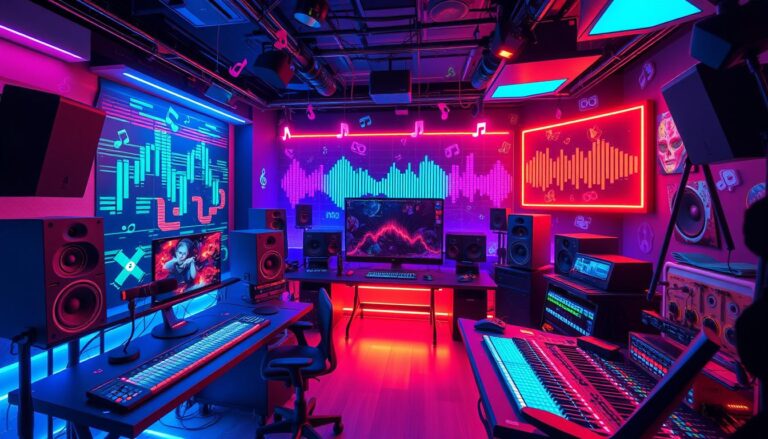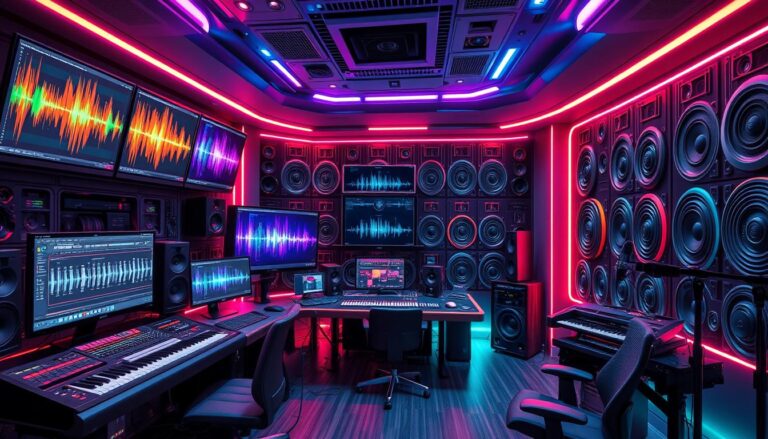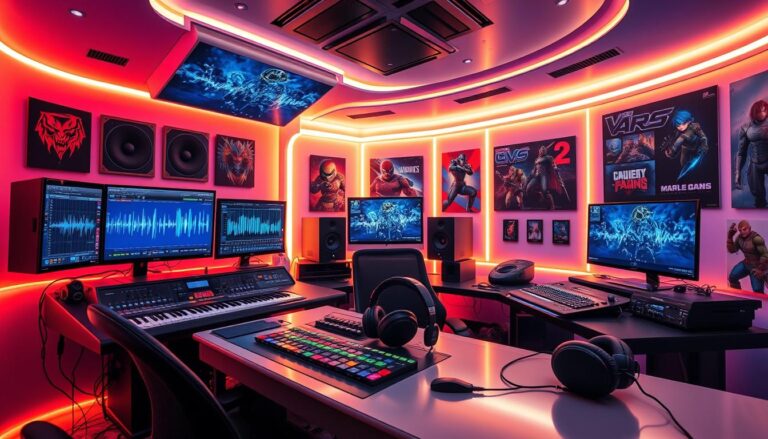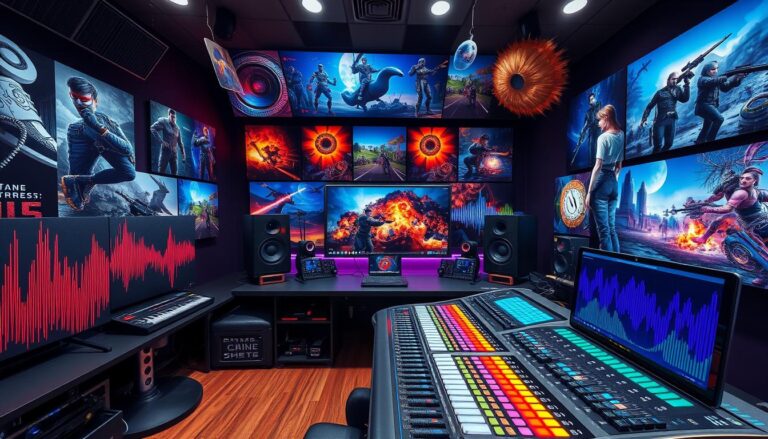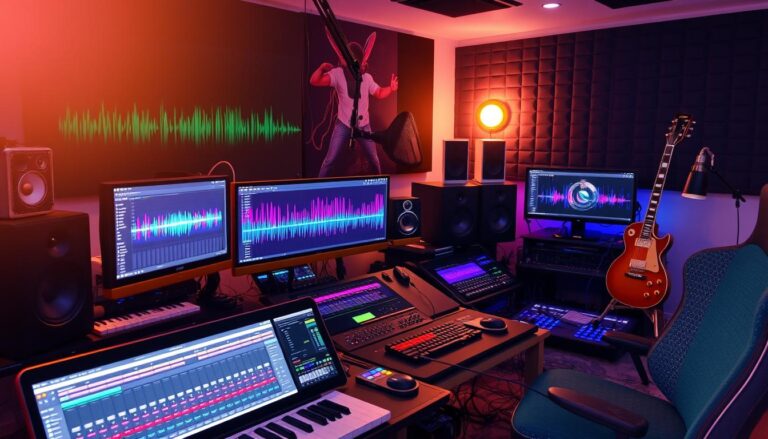What Are the Basics of Audio Mixing in Game Development?
Audio mixing is key in game development, making the player’s experience better. It balances sound effects, Foley, ambient sounds, music, and dialogues. Tools like equalization and volume control are used to make the game sound clear and consistent.
The game mix person works closely with other teams for months or years. They make sure the sound fits with the game’s visuals and story. This teamwork creates a game that feels real and engaging.
Audio mixing is not just about tech; it’s also about art. The mix supervisor makes choices that improve gameplay and storytelling. They ensure every sound fits perfectly, making the game more enjoyable.
Understanding Game Audio Mixing Fundamentals
At the heart of great video game audio is the art of mixing. Game audio mixing is about balancing volumes, managing sound frequencies, adjusting dynamics, and adding depth. This process is key to making the audio quality top-notch and the gaming experience engaging.
Defining Audio Mixing in Gaming Context
In game development, mixing audio means blending different sound elements. This includes foley artistry, ambient sounds, music, and dialogue. The aim is to create a sound environment that fits perfectly with the game’s visuals and gameplay.
Key Components of Game Sound Design
Audio mixers focus on balancing several sound design elements. These are:
- Sound Effects: Sounds like impacts, footsteps, and weapon noises that make the game world feel alive.
- Foley: Sounds that match what’s happening in the game, making it feel more real.
- Ambient Soundscapes: Background sounds that set the mood and pull players into the game’s world.
- Music: Music that adds emotion and moves the story along.
- Dialogue: Voice-overs that tell the story and bring characters to life.
Role of Audio Director in Game Development
The audio director or lead audio designer sets the rules for mixing. They decide on sound placement, volume, and how it sounds in the game. They keep the mix consistent, adjust to changes in gameplay, and meet technical needs for different platforms. Mixing is a back-and-forth process that requires constant improvement as the game evolves.
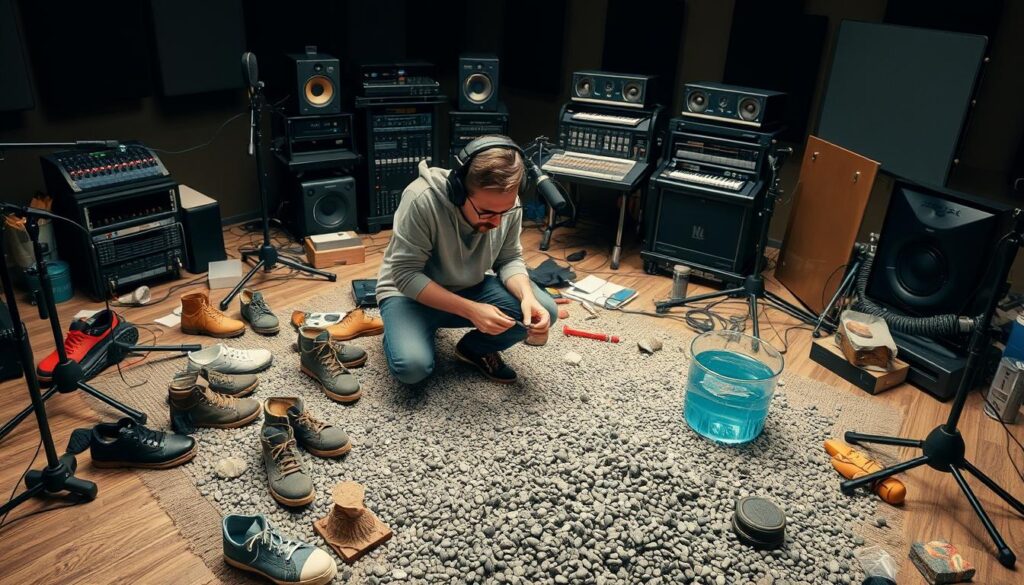
The Importance of Audio Mixing in Gaming Experience
Audio mixing is key to a better gaming experience. It ensures the audio implementation, dialogue recording, and immersive soundscapes that grab players’ attention. Good sound design makes the game feel real, helps with navigation, and brings out emotions that match the story.
Ambient sounds help players feel like they’re in the game’s world. Sound effects, like footsteps and gunshots, add to the action. Music in games makes players feel and follows the story’s flow. Sound designers, game creators, developers, composers, and voice actors all work together to make the game’s sound.
Techniques like binaural audio and spatial audio make games feel more real. Binaural audio mimics how we hear direction and distance, making sounds seem 3D. Spatial audio changes sound based on where the player is, helping with navigation and keeping players engaged.
Auditory feedback makes players feel connected to the game. Sound effects like gunfire or footsteps are crucial in fast games, helping players do better. Sound effects that match what’s happening on screen make the game feel more real and immersive.
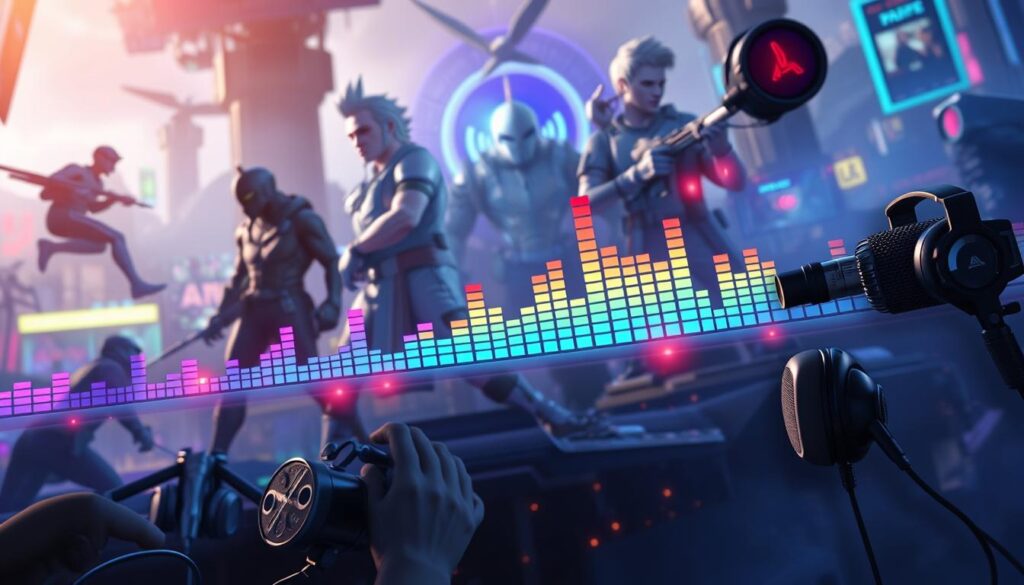
Sound design is vital in games, making environments feel real and emotions stronger. Game audio experts use different sounds, 3D audio, and adaptive audio to create engaging experiences.
Game Sound Design and Audio Effects: Core Elements
In game development, sound design and audio effects are key. They make the game world feel real and engaging. From a dragon’s roar to a quiet forest, these elements bring the game to life.
Sound Effects and Foley Implementation
Sound effects are the heart of game audio. They give players feedback and make the game feel real. Sounds like footsteps, rustling leaves, and clashing swords pull players into the game.
Getting these sounds right is important. They need to fit with the game’s actions and overall sound.
Ambient Sound Design Techniques
Ambient sound makes environments feel alive. Techniques like layered sounds and interactive soundscapes create immersive worlds. These sounds make players feel like they’re really there.
They also add to the game’s emotional feel. This makes the game more engaging and memorable.
Music and Dialogue Integration
Music and dialogue are key for the game’s story and feelings. They help players connect with the game’s world and characters. Dynamic music, like in The Elder Scrolls V: Skyrim, changes with the game.
It’s important to make sure all sounds are clear. This way, players can hear what’s important during the game.
Game sound design combines sound effects, ambient sounds, and music. It uses techniques like sound synthesis and binaural audio. This creates realistic and immersive soundscapes that fit perfectly with the game.
Organizing Mixer Busses for Game Audio
Organizing mixer busses is key in game audio. It’s like music production, with a top-down structure. Sound effects are grouped by type, making audio easier to manage.
This method helps with audio middleware, sound effects library, and immersive soundscapes. It lets you change sound groups easily but also control each sound. Buses are set up for main categories like Character, World, and UI, with subcategories for different sounds.
This organization makes mixing audio easier. It ensures the game sounds great. By using mixer busses, audio pros can work better and make games sound amazing.
| Bus Hierarchy | Subcategories |
|---|---|
| Character |
|
| World |
|
| UI |
|
The guide on Wwise version 2023.1.8 shows how to mix audio well. It helps audio pros make soundscapes that fit the game perfectly.
Dynamic Mix States and Real-time Effects
In game audio, making soundscapes dynamic and interactive is key. Game audio engineers use “dynamic mix states” to do this. These presets on mixer busses let them adjust audio effects in real-time, based on gameplay. This makes the player’s experience better.
Understanding Mix States in Game Audio
Dynamic mix states help game audio pros switch between different audio settings smoothly. Sound designers can change reverb, apply filters, or adjust volume based on player actions. This keeps the audio immersive and in sync with the game’s changes.
Implementing Real-time Audio Effects
Real-time audio effects are vital for an engaging soundscape. Game audio teams use effects like changing reverb based on location, or adjusting volume for in-game events. These effects make the audio and game play together seamlessly.
Parameter-based Audio Modifications
Using parameter-based audio modifications makes audio experiences dynamic. By linking audio parameters to gameplay, sound design can react to player actions. For instance, changing filter frequencies or effect intensity based on health or environment improves audio immersion.
